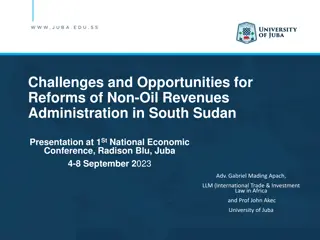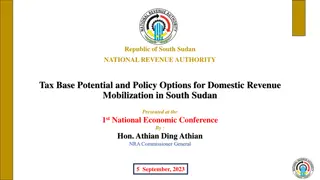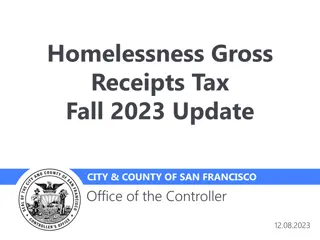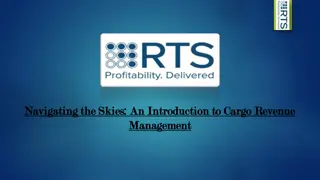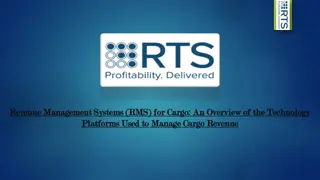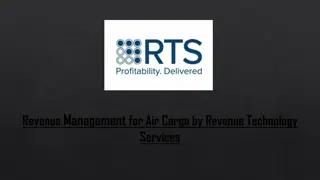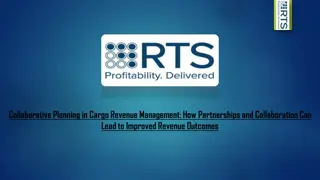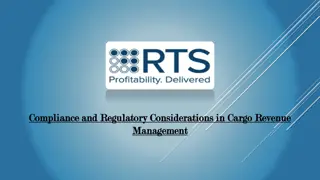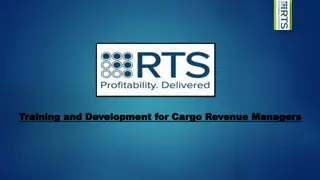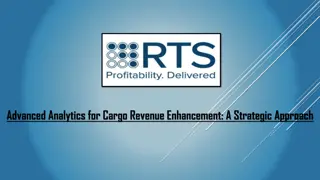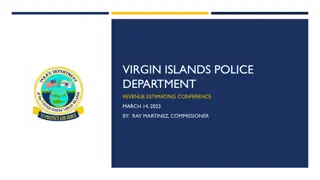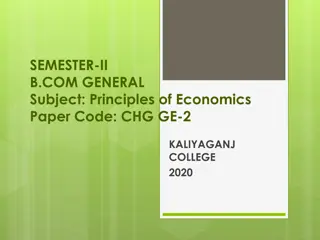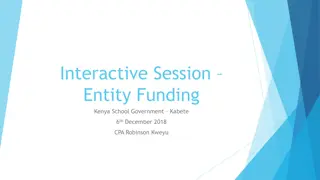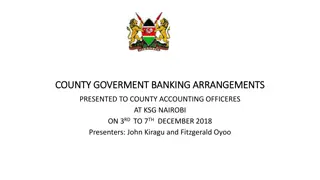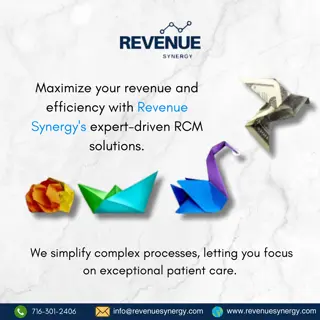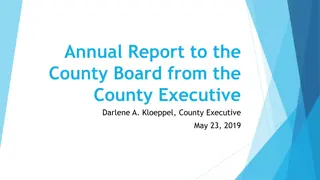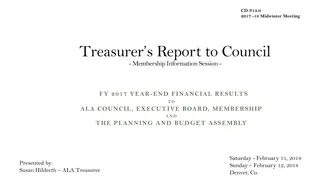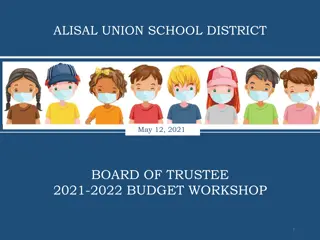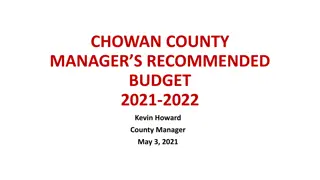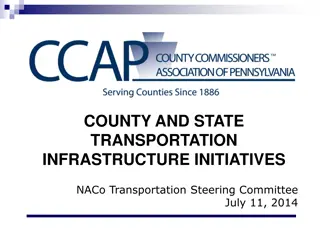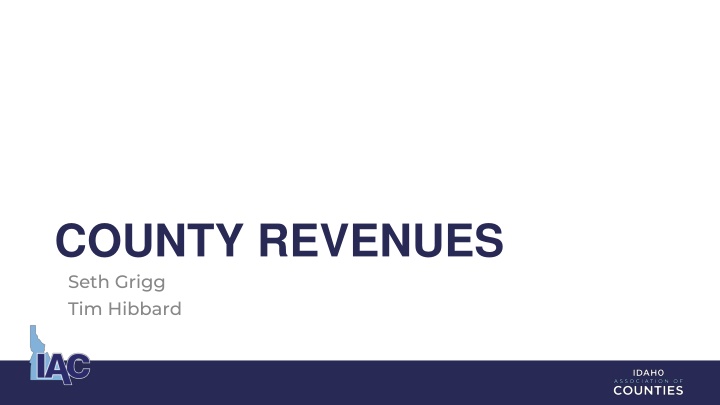
County Revenues and Revenue Sources Overview
Explore the breakdown of county revenues, including dedicated and general funds, revenue sources, state shared revenues, and revenue sharing details. Gain insights into how funds are allocated for various purposes within the county budget.
Download Presentation

Please find below an Image/Link to download the presentation.
The content on the website is provided AS IS for your information and personal use only. It may not be sold, licensed, or shared on other websites without obtaining consent from the author. If you encounter any issues during the download, it is possible that the publisher has removed the file from their server.
You are allowed to download the files provided on this website for personal or commercial use, subject to the condition that they are used lawfully. All files are the property of their respective owners.
The content on the website is provided AS IS for your information and personal use only. It may not be sold, licensed, or shared on other websites without obtaining consent from the author.
E N D
Presentation Transcript
COUNTY REVENUES Seth Grigg Tim Hibbard
COUNTY REVENUE SOURCES Local property taxes State revenue sharing Federal land payments Fees for service Fines Grants Interest Other
DEDICATED (RESTRICTED) REVENUE Revenue that can only be used towards a legally restricted purpose, including: Dedicated property tax revenues (i.e.: justice fund, district court fund, etc.), Highway user revenue, Court revenue, Snowmobile/waterways revenue, 911 fees, Election consolidation revenue, SRS funds, Enterprise funds, and 50% of liquor funds (if not in a community college district).
GENERAL (UNRESTRICTED) REVENUE Revenue that can be used for any government purpose, including: PILT, Sales tax revenue sharing, Property tax replacement (Ag & personal property), Current expense fund property taxes (within funds and levy limits), and 50% Liquor funds (unless in a community college district).
COUNTY BUDGET FUNDS Road & Bridge Community College Parks & Recreation Pest Control Snowmobile Solid Waste Tort Veterans Memorial Waterways Noxious Weed 911 Emergency Communications EMS Enterprise Funds General or Current Expense Airport Ambulance Ad Valorem (Revaluation) Justice Ignition Interlock District Court Election Consolidation Fairgrounds and Buildings Health District Historical Society Charity (Indigent) Trusts Drug Court
REVENUE SHARING State revenue sharing apportionment: $1,320,000 apportioned 1/44 to each county Balance is apportioned based on population Base and excess apportionment (inventory replacement): Base payment fixed at 1999 payment Excess apportioned to counties based on population Section 63-3638, Idaho Code NOTE: Sales tax revenues are very susceptible to economic downturns.
FIXED PROPERTY TAX REPLACEMENT Fixed amounts paid from state sales tax collections for replacement of certain exempted agricultural and business personal property taxes: Agricultural exemption (Section 63-3638(11), Idaho Code) and Business personal property tax exemption (Section 63- 3638(13), Idaho Code).
ELECTION CONSOLIDATION Sales tax distribution to counties to assist with the costs of conducting consolidated elections (Section 63- 3638(8), Idaho Code). $4,100,000 apportionment indexed annually based on CPI: $2,200,000 apportioned equally to 44 counties ($50,000), Balance apportioned based on population.
FISH & GAME FEE IN LIEU OF TAXES (FILT) In 1990 the Idaho Constitution was amended (Article VII, Section 4) to allow the Idaho Department of Fish and Game to collect a fee on lands they manage as a means to hold counties harmless for property taxes lost due to the transfer of private lands to tax-exempt public lands. The fee cannot exceed the property tax for the property at the time of purchase (unless the tax would have increased otherwise). In 2018, there were 210,018 eligible acres subject to FILT (less than half of a percent of Idaho s total acres), totaling an annual statewide fee of $225,916.05.
LIQUOR FUND Revenue sharing from the sale of liquor from state liquor stores. Revenues are distributed 50% to the state/50% to cities and counties. Local share is distributed 60% to cities/40% to counties (will phase in to a 49%/51% split by 2023 as a result of H0643). Up to 50% of county share must be spent on out of district tuition. Any balance of the distribution can be used for any general purpose. NOTE: Counties within a community college district can use 100% of distribution for any general purpose. Section 23-404, Idaho Code
HIGHWAY DISTRIBUTION ACCOUNT Includes fuel taxes, registration fees, and other user generated revenues. 40-701(2) Distribution (highway maintenance and construction): 38% to local units of government, 57% to ITD, and 5% to ISP (will phase out over five years and 40% will be distributed locals/60% to ITD). 40-701(3) Distribution (only highway maintenance): 40% to local units of government and 60% to ITD.
HDA LOCAL DISTRIBUTION 30% to cities by population. 70% to counties and highway districts as follows: 10% allocated equally among 44 counties, 45% allocated based on the number of improved miles, and 45% allocated by number of vehicle registrations in each county.
FEDERAL LAND PAYMENTS
PAYMENT IN LIEU OF TAXES (PILT) General government funding to counties through Payment-in-Lieu-of-Taxes program. Intended to compensate counties for the loss of tax revenues due to the tax exempt status of federal lands. Only counties are eligible in Idaho to receive PILT. Actual payment based on numerous factors, including: Population, Eligible federal land acres, and Prior year federal land payments from other programs.
SECURE RURAL SCHOOLS (SRS) 70% of state payment is distributed to eligible counties and highway districts. 30% is distributed to eligible school districts. Of the 70% apportioned to eligible counties and highway districts: 80-85% for use on road and bridge construction and maintenance (Title I), and 15-20% for special RAC (Title II) and county (Title III) projects. SRS was not funded in 2016. SRS is funded through 2020.
PROPERTY TAXES 44% of county operating revenues come from property taxes Property tax budgets in Idaho are budget driven (not rate driven) Property tax budgets are based on need, not fixed levy rates Prevents volatility
THE PROPERTY TAX BUDGET The 3% Cap Statutory Levy Caps New Construction Revenues Forgone Property Taxes
3% PROPERTY TAX BUDGET CAP Property tax budgets cannot increase by more than 3% (Section 63-802, Idaho Code). The 3% increase is calculated using the highest property tax budget from the previous three years. The 3% cap does not apply to your total county budget. The 3% cap does not apply to new construction revenue or forgone property taxes.
8% PROPERTY TAX BUDGET CAP (H0389) Total property tax budgets cannot increase by more than 8% (Section 63-802, Idaho Code). 8% cap applies include the 3% cap and new construction. 8% cap does not apply to forgone property taxes.
STATUTORY LEVY LIMITS Property tax levies are subject to levy limits (or ceilings). Examples: Current expense levy: .0026 (w/o justice levy) or .0020 (w/justice levy) (Section 63-805, Idaho Code) Justice levy: .002 (Section 63-805, Idaho Code) District court levy: .0004 (Section 31-867, Idaho Code) Charity levy: .001 (Section 31-863, Idaho Code) Once a property tax levy reaches its limit, it cannot be increased.
IMPACT OF BUDGET CAPS ON COUNTIES
NEW CONSTRUCTION New taxable market value from: Construction of new structure, Additions or alterations to existing non-residential structures, Change in land use classification (once improvements are made), Increases over base value in urban renewal revenue allocation area after URA is closed, and Other items allowed under Section 63-301A, Idaho Code.
NEW CONSTRUCTION (H0389) 90% of new construction can be added to the new construction roll. 80% of new construction resulting from the expiration or deannexation of a revenue allocation area can be added to the new construction roll.
NEW CONSTRUCTION (H0389) Steps to calculate new construction budget capacity: Calculate preliminary budget by multiplying 3% increase over highest property tax budget from previous three years. Divide preliminary budget by the sum of the current year locally assessed market value plus the prior year operating property market value. Multiply the product by the new construction roll. The formula: ((Prior Year Budget x 1.03) (CY Loc Value + PYOP Value)) x NC Roll CY Loc = locally assessed taxable value (not including operating property), PYOP = Prior year operating property
COUNTY NEW CONSTRUCTION PROPERTY TAXES Growth pays for itself (Ignore if HB 389 is signed into law). Example Year 1. Budget $100 3 home district: Each home worth $100 Levy rate = $100 budget / $300 of value = .33 Taxes for each home = $33 Year 2 New home built worth $100. Value multiplied by previous year levy rate. Add to budget ($33). New budget is $133. New levy = $133 budget / $400 of value. = .33 Everyone s taxes stayed flat at $33, despite 100% new construction. Growth paid for itself!
FORGONE PROPERTY TAXES Forgone property taxes include amounts that could have been budgeted under the 3% cap but were not. Authority to budget forgone property taxes never ends. Tax Commission compiles and maintains list of available forgone property taxes for all taxing districts. Forgone property taxes should not be treated as a property tax savings account. Forgone property taxes can only be budgeted during the annual timeframe allowed for setting property tax budgets and levies.
CHANGES TO FORGONE (H0389) A taxing district can budget 1% of its property tax budget from forgone for ongoing maintenance and operation. A taxing district can budget 3% of its property tax budget from forgone for capital project (3% not included in base budget) A taxing district can budget any and all forgone up to 8% if the district does not budget 3% increase or new construction.
BUDGETING FORGONE PROPERTY TAXES If a taxing district budgets forgone property taxes, it must: Provide public notice of its intent to budget forgone property taxes, Hold a public hearing about the budgeting of forgone property taxes, Pass a resolution stating the purposes for which forgone property taxes are being budgeted, and File a copy of the resolution with the county clerk who then files it with the State Tax Commission. Tip: Hold public hearing on forgone property taxes in conjunction with your annual budget hearing.
DISCLAIMING FORGONE PROPERTY TAXES A taxing district may disclaim all or a portion of forgone property taxes resulting from a district not budgeting the full 3% in that budget year. To disclaim forgone property taxes a district must: Provide public notice of its intent to disclaim forgone property taxes, Hold a public hearing about disclaiming forgone property taxes, Pass a resolution disclaiming forgone property taxes, and File a copy of the resolution with the county clerk who then files it with the State Tax Commission. NOTE: Forgone property taxes can only be disclaimed at the annual budget hearing.
EXEMPTIONS Because Idaho local governments operate under a budget driven property tax system, exemptions create tax shifts. If one class of property owners is granted an exemption, the other classes of property owners must pick up the tab. Exemptions also result in levies hitting levy limits. 2020 Stats: Full Market Value: $231,660,041,113 Net Market Value: $191,696,914,572 17.25% of property value is tax exempt
EXEMPTIONS CREATE TAX SHIFTS Curley benefits from a 50% Curley benefits from a 50% property tax exemption. property tax exemption. No property tax exemptions. No property tax exemptions. Moe $100 Larry $100 Moe $125 Larry $125 Curley $100 Curley $50
IMPACT OF EXEMPTIONS 3.1% 24.0% 85.0% 96.9% 76.0% 15.0% Residential Agricultural Taxable Commercial Exempt
TAX SHIFTS DUE TO DIFFERENCES IN VALUE INCREASES Because Idaho local governments operate under a budget driven property tax system, differences in growth can also cause tax shifts. The amount of property taxes one pays is not solely based on value, but RELATIVE VALUE. Example 3 home district, each worth $100, budget is $100. Levy = .33. Taxes for each are $33.33. One home goes up 25%, the others go up 10%. What happens? Everyone s taxes go up?Nope. Levy rate goes down to .289 (more value = total of $345). What happens? Everyone s taxes go down?Nope. Home one s taxes go up to $36.23, everyone else's taxes go down to $31.88.
MARKET VALUE & SHARE OF PROPERTY TAXES
PROPERTY TAX BUDGET CONSIDERATIONS Delinquent property taxes Property tax appeals Cannot increase collections from certified levy amount(s)
MISCELLANEOUS PROPERTY TAX PROVISIONS Assessment Notice Appeals Process County Board of Equalization Levy Certification Tax Notices
COUNTY FEES FOR SERVICE 31-870. FEES FOR COUNTY SERVICES. (1) Notwithstanding any other provision of law, a board of county commissioners may impose and collect fees for those services provided by the county which would otherwise be funded by ad valorem tax revenues. The fees collected pursuant to this section shall be reasonably related to, but shall not exceed, the actual cost of the service being rendered. Examples: Enterprise fees Copy, records fees Building permits and fees
COUNTY FEES WITH SPECIFIC STATUTORY AUTHORITY Franchise fees Impact fees Computerized mapping fees Vehicle licensing and registration admin fees
STATUTORY FEES District Court Fees Driver License Fees e911 Fees Recording Fees Etc.
CASH FORWARD/FUND BALANCE DRAW Revenues from reserve accounts/fund balances can be budgeted PILT/SRS fund balances Dedicated fund balances can only be used for dedicated purposes

